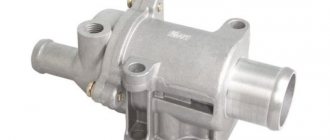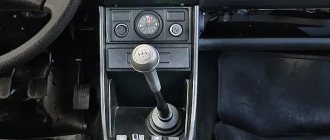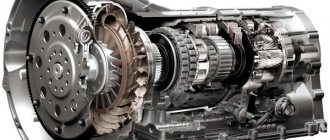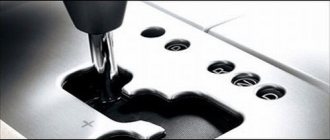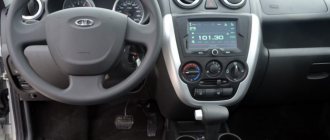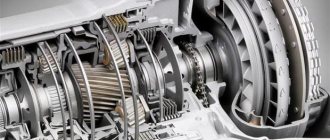In the circles of car owners and enthusiasts you can often hear about the Lada Vesta automatic - is it a myth or reality? What is the actual basis for such conversations? There are rumors surrounding two types of transmissions: automatic transmission and CVT. Perhaps in the future, they will appear on Vesta, fortunately, there are prerequisites for this. Each transmission is special and has its own characteristics! After reading this article you will understand which of the Vesta boxes is suitable for you.
- What kind of gearbox does the Lada Vesta have?
- What kind of robot is on the Lada Vesta
- Disadvantages of the robot
- Advantages of the robot
- Price of a robotic box for Lada Vesta
- How to ride a robot
- Manual Transmission
- Pros of mechanics
- Disadvantages of manual transmission
- Price of cars with mechanics
- Rumors about a CVT on Vesta
- Automatic expected
What kind of gearbox does the Lada Vesta have?
Lada Vesta is available with two types of transmissions: manual and robotic. Both are made in Russia. Until recently, AvtoVAZ installed 5 manual transmissions (manual transmission) from Renault. This is due to the inconsistency of the old VAZ-21080 with the established Vesta standards. I had to modify the Priora box. To increase the gear ratios of the gearbox, the main pair, the second gear gears, was replaced. The new VAZ has a new body, stronger rubber parts, which means the noise level is an order of magnitude lower. Replacing oil seals will be less frequent, adding less oil to the box will increase, torque, acceleration, and maximum speed will increase. With an improvement in gearbox performance, fuel consumption increases by 0.6 liters. Now in mixed mode - 7.5 liters per 100 km. With a new one, 6.9 was enough for the same distance.
Externally, it will not be possible to distinguish a foreign box from a VAZ one. They look the same inside and below. You can find out the manufacturer by the vehicle's VIN code. The combination “GFL11” means that the machine has a Russian node, and “GFL13” means a French one.
The combination “GFL12” indicates AMT on Vesta. 5 AMT - five-speed automated transmission, in common parlance - a robot. Many people mistakenly call manual transmission an automatic transmission. This is wrong. Perhaps they are similar in appearance due to the lack of a clutch pedal. The robot can rather be called a semi-automatic, or a modernized manual transmission. It engages and disengages the clutch, upshifts and downshifts independently, but is designed almost the same as a manual gearbox. Note that the domestic development of its own robot is successful, perhaps they will soon be installed on Renault.
The Lada Vesta sedan and SV Cross have AMT, and it should soon appear in the CIS. Installed together with VAZ 21129 (1.6 l; 106 hp), HR16DE-H4M (1.6 l; 114 hp) and VAZ 21179 (1.8 l; 122 hp) engines.
Available configurations
If you go to the official website lada.ru, you will see that the most affordable configuration of the Vesta SV Cross, on which you can install a robotic box, is Luxe with the assigned code GFK32-52-X00. Its cost is 845,900 rubles. A machine of this configuration is equipped with almost everything necessary, is very comfortable and safe.
The next model configuration is called Luxe Multimedia with code GFK32-52-XK2. The price tag for it is higher than the previous one and equals 873,900 rubles. As is clear from the name of the configuration, the difference between it lies in multimedia. The more expensive trim level is equipped with a navigation system and six speakers, while the poorer trim level has “only” four speakers.
The last, most expensive trim level is Luxe Prestige. Code designation GFK32-52-XSH. It differs from the “multimedia” version in the presence of a rear armrest, tinted rear windows, a power outlet in the rear and heated rear seats. For the “fattest” configuration you have to pay 891,900 rubles.
To confirm our words about the cost of a robotic box, we offer you a few simple steps. Pay attention to the Luxe Multimedia package, but with a manual transmission.
Read also: Bubbles after painting a car
As you can see in the picture, the cost of a model with this equipment is 823,900, which is exactly 25,000 cheaper than with AMT. Simple math in action.
What kind of robot is on the Lada Vesta
The Vesta robot was created on the basis of a VAZ 21827 manual transmission, to which a control unit, actuators and drives from the German company ZF were added. AMT transmission sensors are connected to the Lada's on-board computer. The most useful feature in Vesta is the indicator with gear shift prompts. The hint of Lada Vesta is two triangles pointing up and down. When one of them lights up, it means you should engage an upshift or downshift. This option is accompanied by sound, which can be disabled.
AMT automatically releases the clutch electronically. To start moving, you need to remove the lever from the neutral position and press the accelerator pedal. To bring the Vesta robot as close as possible to the machine, there is. The chipped Lada begins to move when the brake pedal is released.
Disadvantages of the robot
The robotic transmission has been discontinued overseas due to a number of problems. They are also present on the Lada Vesta AMT.
Gear shifts abruptly, jerks in movement are possible; The semi-automatic machine “thinks” for a long time; during dynamic driving, it does not put the required pair of gears into operation at the right time; On an ascent, it downshifts belatedly.
The disadvantages are less noticeable if you drive smoothly and do not brake or accelerate sharply.
Advantages of the robot
Why did AvtoVAZ decide to produce Vesta with this type of box? The fact is that:
The robotic gearbox of the Lada Vesta is cheaper to construct than a classic automatic; Vesta with a robot uses fuel more economically, unlike other gearboxes; A special feature of AMT in comparison with automatic transmission is almost three times less transmission oil consumption; The electronic mechanism provides protection against engaging the wrong gear while driving (this happens on mechanics); The robot rarely breaks down and does not need to be frequently diagnosed and maintained; The clutch engages and disengages smoothly when starting off and changing gears, the lever does not vibrate while driving; Manual transmission is less noisy than manual transmission; Inside the box there is an option to compensate for clutch wear - it further extends the service life of transmission elements; The box is used in automatic or manual mode, whichever is more convenient.
Manual Transmission
Lada Vesta is a car created from scratch, with its own base. For Vesta, the basis of the Lada S and Lada B was specially designed with a new steering, brake system and radiator from Renault Megane. The manual gearbox was initially borrowed from the Renault-Nissan concern. AvtoVAZ’s policy is aimed at developing its own components and equipping new Ladas with them to the maximum. It was not possible to supply the outdated VAZ-2180. They decided to modernize it, in fact it turned out to design a completely new, modern, silent box. A year after the start of sales, it appeared.
Pros of mechanics
New mechanics 21807 with low noise level. Speeds are switched comfortably and smoothly, the lever comes exactly to the required speed. Of course, acceleration with a manual transmission is better; the transmission does not wait for a command from the crankshaft speed sensor. Manual transmission requires the least amount of oil. In winter, the engine starts easier. The mechanics are cheap to maintain and repair and do not require any special care. When driving off-road and in snow, a manual transmission has no equal. Unlike the robot, the owners note that the mechanics do not “stupid” or “twitch”—the robot does not boast about this.
Disadvantages of manual transmission
Difficult when starting from a stop and when moving uphill - you need experience. You have to get used to a car with a manual transmission, feel for the desired speed range, press the clutch pedal, feel the moment of need to change gear. While the driver is inexperienced or getting acquainted with a new car, the clutch and the engine with gearbox wear out a lot. The domestic transmission consumes more gasoline than its French sister and AMT. Of course, mechanics are not as convenient as an automatic machine or a robot. When driving for a long time, the driver gets more tired, and it is not convenient in a traffic jam.
Acceleration dynamics of Lada Vesta SV Cross 1.8 AMT
In conclusion, we suggest that you familiarize yourself with the video that demonstrates the overclocking of the Vesta SW Cross. According to the manufacturer, the station wagon accelerates from 0 to 100 km/h in 13.3 seconds, which is very good figures for a car of this size.
We boldly declare that the most anticipated car in our country in 2021 is the Russian Lada Vesta SW Cross station wagon, namely the all-terrain version. Let us remind you that the Cross differs from the standard station wagon in that it has increased ground clearance by 25 mm, the presence of plastic body protection all around, as well as richer equipment. On our own behalf, we can add that when choosing between two cars, we would give preference to the Vesta SV Cross, because this car looks more interesting, and in terms of characteristics, the Cross is a little more attractive than its brother. It is also worth considering that the all-terrain version is slightly more expensive than a regular station wagon; the difference in the price of the basic versions is about 116,000 rubles.
On our website we have already talked about the robot on Vesta SV Cross, today we would like to take a closer look at the versions equipped with a manual gearbox.
Rumors about a CVT on Vesta
It is already known that the Renault Nissan concern, together with AvtoVAZ, is working on installing a continuously variable transmission on Vesta. To install an imported gearbox, you will need to install a new engine, most likely also foreign-made. The release date of the Lada with a CVT is not known, let’s assume that it’s not worth waiting for such a car within the next three to four years.
With a CVT, Vesta will become more economical than it is now. The ride will become smooth without changing gears. One “but” is that repairing a variator is astronomically expensive; Lada manufacturers should think carefully about this.
Automatic expected
Many people are concerned about the issue of the machine gun. The predecessors Kalina and Grant already had a four-speed Jatco automatic, why isn’t it on the 2180? The fact is that there is no suitable base for the machine gun on the Lada Vesta. The mentioned box is already outdated, and purchasing a new one will significantly increase the price of the car, which is contrary to the policy of the Volga Automobile Plant.
Company President Nicolas More denied rumors about a 4-band automatic transmission for the most popular Lada models. So will the Lada Vesta have a gun? Most likely Yes. It will be a 6-speed modern transmission. Negotiations are already underway on the creation of a new plant in the Russian Federation; automatic transmissions will be created at the plant with the support of foreign companies. The appearance of an automatic machine on the Lada Vesta should be expected in at least 4-6 years.
Alternative, what to choose for this money?
Agree, it’s difficult to realize that the cost of a domestic car can be more than 800,000 rubles. Probably every car owner will think several times about what new cars he can buy for this amount, besides Vesta. It is noteworthy that SW Cross simply has no competitors in this segment; many will choose between Vesta SV Cross and Solaris, Rio, Polo sedan and Rapid. Of all the above, we would give preference to Rapid, because The trunk of a Czech car is more spacious, and there is the option of choosing an automatic transmission. Not many journalists mention that for the amount of 890,000 rubles you can buy a Renault Duster crossover with a 2.0 liter gasoline engine and all-wheel drive. Yes, of course, the Duster will be more expensive, but you will get all-wheel drive.
Another alternative is to consider purchasing the Chinese crossover Chery Tiggo 2
This model, in our opinion, also has a very attractive interior and exterior design; moreover, the technical parameters of the Chinese crossover and the domestic station wagon are similar. Both cars have plastic body protection, high ground clearance and front-wheel drive. Chery Tiggo 2 is equipped with a 1.5 liter petrol engine producing 106 hp. The price of a car in Russia, depending on the configuration, varies between 598,000 – 789,900 rubles.
Read also: Lamps for painting booths
This list may also include a huge list of Chinese crossovers whose price will be comparable to the all-terrain version of the station wagon.
I don’t like Chinese cars, ok, as an alternative you can consider the Korean crossover Hyundai Creta
Yes, of course, it will be a car with a basic configuration and front-wheel drive, but you will receive a 5-year warranty, a 1.6 liter gasoline engine and a 6-speed manual transmission, a high seating position, an attractive design and, most importantly, reliability.




